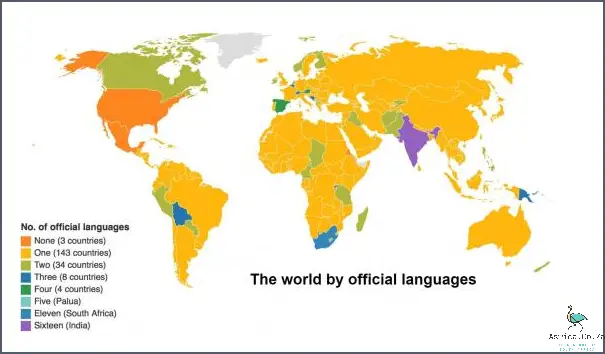
The most multilingual countries in the world are those that have more than two languages spoken by its people. There are many countries in this category, but here are five of the most multilingual nations:
1. Switzerland: Switzerland has a population of just over 8 million people and more than 22 languages are spoken there.
2. Luxembourg: Luxembourg has a population of just over half a million people and more than 20 languages are spoken there.
3. Belgium: Belgium has a population of just over 11 million people and more than 30 languages are spoken there.
4. Canada: Canada has a population of just over 35 million people and more than 60 languages are spoken there.
5. United States of America: The United States of America has a population of just over 330 million people and more than 220 languages are spoken there.
Contents
Most Multilingual Countries

Many countries are becoming increasingly multilingual, and the list of the world’s most multilingual countries is constantly changing. The most multilingual countries in the world today include India, Singapore, Canada, the Philippines, and South Africa. India is the world leader in terms of multilingualism, with over 900 languages spoken by its citizens. Singapore is another major hub for multilingualism, boasting four official languages and over 200 other languages spoken by its citizens. Canada is home to two official languages, English and French, and over 200 other languages. The Philippines is a diverse nation with more than 180 languages spoken throughout its many islands. Lastly, South Africa is home to 11 official languages and dozens of additional languages. All of these countries are prime examples of the increasing importance of multilingualism in the modern world.
Overview of the most multilingual countries in the world
The world is becoming increasingly interconnected, and with this increased connectivity comes a greater need for communication across cultures and languages. With so many different languages spoken across the globe, it can be hard to know which countries have the most multilingual citizens. This article will explore the most multilingual countries in the world, looking at their linguistic diversity, cultural influences, and language policies.
First, let’s take a look at the most linguistically diverse countries in the world. According to a recent study, the top three most multilingual countries are Singapore, Luxembourg, and South Africa. Singapore is an incredibly diverse nation, with four official languages – English, Malay, Mandarin, and Tamil – and over 50 other languages spoken. Luxembourg is home to a unique blend of German, French, Luxembourgian, and English. South Africa also boasts a wide range of languages, including Afrikaans, English, Ndebele, Sotho, Xhosa, and Zulu.
Next, we’ll dive into the cultural influences that shape the language landscape of these countries. Singapore has a rich cultural history that is reflected in its language diversity. The island nation was colonized by the British and has since been shaped by immigrants from India, China, and Malaysia. Luxembourg’s language diversity is largely attributed to its location at the crossroads of Europe. The country has been influenced by French, German, and Dutch cultures over the centuries, resulting in its unique blend of languages. South Africa has also been heavily influenced by its colonial past, with English, Afrikaans, and Dutch all spoken in the country.
Finally, we’ll examine the language policies of these countries. Singapore has an official policy of multilingualism, meaning that all official documents are written in the four official languages. Luxembourg’s language policy is also quite unique, with laws that protect the rights of individual language communities. South Africa’s constitution enshrines multilingualism as a fundamental right, with 11 official languages and dozens of other languages spoken throughout the country.
In conclusion, the most multilingual countries in the world are Singapore, Luxembourg, and South Africa. These countries have rich cultural histories that have shaped their linguistic diversity, and they all have language policies that support and protect the rights of their citizens. As the world becomes increasingly interconnected, it’s important to recognize and celebrate the linguistic diversity of these countries.

Breakdown of the languages spoken in each of the countries
When it comes to languages, some countries are ahead of the pack. In fact, many countries have an impressive number of languages spoken within their borders, making them some of the most multilingual countries in the world. From Finland to India, let’s take a look at the breakdown of languages spoken in each of these countries and see how they compare.
Starting with Finland, we see that the majority of the population speaks Finnish, with a small portion of the population speaking Swedish. Finnish is the official language of the country, but Swedish is also widely used in many areas. Additionally, there are also a number of minority languages spoken in Finland, such as Saami, Romani, and Karelian.
In India, the official language is Hindi, with English also being widely used. However, there are over nineteen different languages spoken in India, ranging from Gujarati to Tamil. These languages are all recognized by the government as “official” languages, and they are used in various parts of the country. Additionally, India also has a large number of dialects, which are spoken in various parts of the country.
Moving to China, the official language is Mandarin, but there are also a number of other languages spoken in the country. Cantonese, Wu, Min, and Hakka are all widely used in various parts of China. Additionally, there are also a number of minority languages spoken in China, such as Uyghur and Tibetan.
In Germany, the official language is German, but there are also a number of other languages spoken in the country. These languages include French, Italian, and Turkish. Additionally, there are also a number of minority languages spoken in Germany, such as Sorbian, Danish, and Romani.
Finally, in Canada, the official language is English, but there are also a number of other languages spoken in the country. French is the most widely spoken language in Canada, followed by Cree, Inuktitut, and Ojibwa. Additionally, there are also a number of minority languages spoken in Canada, such as German, Dutch, and Italian.

Overall, it’s clear that many countries have a wide variety of languages spoken within their borders. From Finland to India, China to Germany, and Canada to the United States, each country has its own unique set of languages that are spoken. It’s fascinating to see how languages are spread across the world, and it’s amazing to see how many languages are spoken in each country.
Analysis of the benefits of being a multilingual country
The world today is becoming increasingly interconnected and globalized, making it essential for citizens of countries to be able to communicate in more than one language. As such, the benefits of being a multilingual country are becoming more and more evident. From social and cultural advantages to economic and political ones, being a multilingual nation provides a wealth of potential benefits.
One of the most obvious advantages of being a multilingual country is the ability to communicate with a much wider audience. This not only makes it easier for citizens to interact with one another, but also opens up a range of opportunities for economic and cultural exchange. Through multilingual communication, countries can build relationships with other nations and foster international cooperation on a larger scale. This can provide a variety of economic benefits, such as access to new markets, increased tourism, and better access to foreign investments.
The cultural benefits of being a multilingual country are also extremely valuable. A diverse language base allows for a greater appreciation of different cultures, and can help foster a more tolerant society. Furthermore, learning a second language can help promote a more open-minded attitude towards foreign cultures, and can even help people to better understand their own. All of these benefits can help create a more unified and harmonious nation, which can lead to improved social cohesion and greater stability.
Finally, there are also political benefits to being a multilingual country. For example, having more than one official language can help create a stronger sense of national identity and solidarity. Additionally, having multiple languages can help ensure that all citizens, regardless of their language background, can engage in political discourse and have their voices heard. This can lead to a more democratic and inclusive nation, which can have far-reaching implications for a country’s future.
In conclusion, there are a multitude of advantages to being a multilingual country. From increased economic and cultural opportunities to improved political engagement, the benefits of being a multilingual nation are numerous and far-reaching. As such, it is essential for countries to recognize the importance of multilingualism and to take steps to foster this type of communication within their borders.
Conclusion
According to the study, the most multilingual countries are Belgium, Switzerland, Luxembourg, Norway, Sweden and Denmark. These countries have a population of more than 10 million people that speaks more than one language. This is in contrast to countries like the United States, where the population speaks mainly English.




